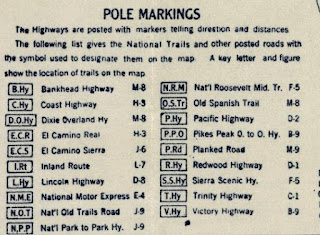Former US Route 40-95 in the City of Lovelock, Nevada was located on Cornell Avenue. Lovelock is the Pershing County Seat and has been part of several major transcontinental corridors of travel dating back to the migrant days of the California Trail. US Route 40 was truncated out of Nevada in 1975 but Cornell Avenue wasn't bypassed by Interstate 80 until 1983. Pictured above is Main Street on Nevada State Route 398 facing towards the Pershing County Courthouse.
Part 1; the history of US Route 40-95 on Cornell Avenue in Lovelock
Lovelock lies within the Humboldt River Basin of the Great Basin Desert. During the period of the California Gold Rush the area which is presently occupied by the City of Lovelock was part of a marsh known as Big Meadows. The waters of Humboldt Lake, Humboldt River and Big Meadows came to be a well known stopping point for migrants on the California Trail. Big Meadows can be seen on the 1863 DeGroot's Map of Nevada Territory north of Humboldt Lake on the California Trail of Humboldt County.
Nevada obtained Statehood during October of 1864 largely off the prospects of the mining booms associated with the Comstock Lode. In 1866 George Lovelock purchased 320 acres of land along the Humboldt River. During the construction of the Central Pacific Railroad George Lovelock sold 85 acres of his property to the railroad developers. During August of 1868 the town of Lovelock was formally plotted by the Central Pacific Railroad. The town name of "Lovelock" was taken from it's benefactor. Lovelock can be seen on the 1873 Bancroft's Map of California, Nevada, Utah and Arizona along the Central Pacific Railroad and a spur of the California Trail north of Humboldt Lake.
Lovelock incorporated as a City during 1917. In 1919 Pershing County split from Humboldt County and Lovelock was selected as the County Seat. Lovelock can be seen on the Victory Highway and Pikes Peak Ocean to Ocean Highway on the 1920 Clason Roads of California and Nevada Map.
During March of 1914 the Pikes Peak Ocean to Ocean Highway was formalized as a coast to coast highway. As originally conceived the Pikes Peak Ocean to Ocean Highway would have been plotted from Washington D.C. to San Francisco which would have put Lovelock on it's alignment. The creation of the National Old Trails Road shifted the east terminus of the Pikes Peak Ocean to Ocean Highway to New York whereas the creation of the Lincoln Highway saw the western terminus shifted to Los Angeles. The Pikes Peak Ocean to Ocean Highway was ultimately completed by 1924 as a highway aligned between Los Angeles and New York.
The Victory Highway was formally organized during 1921 as a coast to coast highway aligned from New York to San Francisco. Unlike the Pikes Peak Ocean to Ocean Highway the alignment of the Victory Highway ultimately always had Lovelock on it's course. The Victory Highway Association lived on after the creation of the US Route System and became the US Route 40 Association in 1938.
During November of 1926 the US Route System was approved by the AASHO. US Route 40 can be seen aligned over top the Victory Highway through Nevada and by proxy Lovelock on the 1927 National Map Company Sectional Map. US 40 was always aligned on Cornell Avenue in Lovelock. Within Nevada US 40 was carried by the designation of Nevada State Route 1 ("NV 1").
On June 29th, 1956 the Federal Highway Aid Act of 1956 was signed into law on the Federal Level. The Federal Highway Aid Act of 1956 was the genesis point of the Interstate Highway System which would in the coming decades sew the demise via of US 40 in Nevada with replacement by Interstate 80.
On November 15th, 1974 the Nevada Department of Transportation in conjunction with states of California and Utah submitted a request to truncate US 40 from Truckee, California to Park City, Utah. The request to truncate US 40 was approved by the AASHO Executive Committee on June 17th, 1975. This action officially removed US 40 from the State of Nevada and left on US 95 alone on Cornell Avenue in Lovelock. The Nevada Department of Transportation noted that they intended to retain US 40 signage on segments of highway not yet bypassed by Interstate 80.
In 1976 during the Nevada State Highway Renumbering existing US 95 on Cornell Avenue was assigned as part of NV 396. The Interstate 80 bypass of Lovelock was completed during 1983. The completion of Interstate 80 saw US 95 realigned off of Cornell Street onto a multiplex of the freeway. This left NV 396 signed over much of what the Interstate 80 Business Route on Cornell Avenue in Lovelock. The completed Interstate 80 through Lovelock can be observed on the 1983-84 Official Highway Map of Nevada.
















































Comments